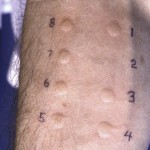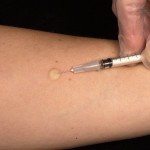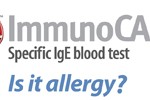Overview
After taking a detailed history, your allergist may decide to perform some allergy tests to figure out what you are allergic to. Bear in mind that when you have a positive test result, it means your body is “sensitized” to the allergen, but it does not necessarily mean you are “allergic” that your body will react to that allergen. For example, you may be tested positive to peanut. If you are eating peanut without any problem, then you are not allergic to peanut, and you should not stop eating peanut only based on the positive test result. So clinical history is the most relevant factor in determining what to be tested and how the test result is interpreted.
Skin Tests
 IgE antibodies against specific allergens are responsible for immediate type of allergic reactions. Skin prick test is used to detect or confirm IgE-mediated sensitivity to airborne allergens, foods, venoms, or medications. A small amount of certain allergen is placed into your skin (arm or back) by “pricking”. If you are sensitized to that allergen, your skin at the prick site will swell up to make a wheel. Usually there is also an area of redness around the wheel, and you will feel itchiness. The size of the wheel needs to be 3mm or more than the size caused by salt water, which serves as a negative control, to be considered positive. The test takes about 15 minutes. It is sensitive and reliable. The wheels usually disappear in 30 minutes.
IgE antibodies against specific allergens are responsible for immediate type of allergic reactions. Skin prick test is used to detect or confirm IgE-mediated sensitivity to airborne allergens, foods, venoms, or medications. A small amount of certain allergen is placed into your skin (arm or back) by “pricking”. If you are sensitized to that allergen, your skin at the prick site will swell up to make a wheel. Usually there is also an area of redness around the wheel, and you will feel itchiness. The size of the wheel needs to be 3mm or more than the size caused by salt water, which serves as a negative control, to be considered positive. The test takes about 15 minutes. It is sensitive and reliable. The wheels usually disappear in 30 minutes.
 Intradermal skin test is used when skin prick test is negative but your allergist is not convinced that you do not have allergy to that particular allergen. A small amount of diluted allergen is injected inside the skin using a very thin needle. The result is also read in 15 minutes based on the size of the wheel compared with that from salt water. It is potentially more sensitive than skin prick test. It may be used for airborne allergens and medications, but not food allergens.
Intradermal skin test is used when skin prick test is negative but your allergist is not convinced that you do not have allergy to that particular allergen. A small amount of diluted allergen is injected inside the skin using a very thin needle. The result is also read in 15 minutes based on the size of the wheel compared with that from salt water. It is potentially more sensitive than skin prick test. It may be used for airborne allergens and medications, but not food allergens.
Blood test
 Blood test can detect allergen-specific IgE in the serum. They are used when you are taking some anti-histamine that blocks skin reactivity, or the skin condition is not optimal for testing, or skin test is not considered safe. Overall, there is good concordance between skin test and blood test. Sometimes they may be complimentary. In general, skin tests are more sensitive than blood test. Serum IgE levels for some major food allergens, if performed by certain method, can be used to predict the likelihood of having a reaction.
Blood test can detect allergen-specific IgE in the serum. They are used when you are taking some anti-histamine that blocks skin reactivity, or the skin condition is not optimal for testing, or skin test is not considered safe. Overall, there is good concordance between skin test and blood test. Sometimes they may be complimentary. In general, skin tests are more sensitive than blood test. Serum IgE levels for some major food allergens, if performed by certain method, can be used to predict the likelihood of having a reaction.
Neither the size of the wheel from skin test nor the level of blood IgE correlates with allergy severity.
Challenge Tests
 When a definitive diagnosis cannot be reached even after skin test and blood test, your allergist may perform a challenge test to the suspected agent. This commonly happens in food allergy or medication allergy cases, and a challenge test is considered golden standard for diagnosis. During a challenge, your allergist gives you suspected food / medication in measured incremental doses, starting from very small amount until a full dose is finished cumulatively, and monitors any reaction in between doses and for an extend period after the final dose. If an allergic reaction happens, you allergist will stop the challenge and treat you with appropriate medications.
When a definitive diagnosis cannot be reached even after skin test and blood test, your allergist may perform a challenge test to the suspected agent. This commonly happens in food allergy or medication allergy cases, and a challenge test is considered golden standard for diagnosis. During a challenge, your allergist gives you suspected food / medication in measured incremental doses, starting from very small amount until a full dose is finished cumulatively, and monitors any reaction in between doses and for an extend period after the final dose. If an allergic reaction happens, you allergist will stop the challenge and treat you with appropriate medications.
Patch test
 If your allergist suspects allergic contact dermatitis, patch test will be performed. During a patch test, small quantities of allergens embedded in adhesive tapes are applied on the skin, usually on the back. You will be instructed how to take care of the tapes. Your doctor will remove the patches after 48hr and make an initial reading. Another reading is performed after 72 to 96hrs. A red rash will develop under the patch if you are sensitive to a particular substance.
If your allergist suspects allergic contact dermatitis, patch test will be performed. During a patch test, small quantities of allergens embedded in adhesive tapes are applied on the skin, usually on the back. You will be instructed how to take care of the tapes. Your doctor will remove the patches after 48hr and make an initial reading. Another reading is performed after 72 to 96hrs. A red rash will develop under the patch if you are sensitive to a particular substance.